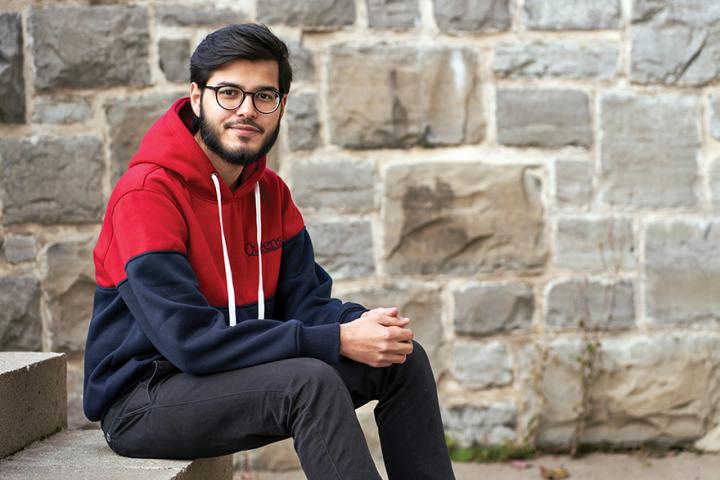When a woman walks through the door of the Ban Righ Centre, she’s not just entering a 100-year-old house; she’s entering a home – a home with a long legacy of Queen’s women supporting each other.
There is a spacious living room with couches, and the upper floors have desks for study time, a bed for nap time, and a dedicated room for breastfeeding. In the kitchen, there’s an ample supply of tea and coffee, and at lunchtime there’s a pot of fresh, hearty soup on the stove.
The homey atmosphere is also fostered by the people who spend time there: students and dedicated staff who are quick to offer a smile, a shoulder to lean on, a hug.
The Ban Righ Centre is designed to feel like a home away from home; that feeling is part of its mission. The raison d’être of the old brick home at 32 Bader Lane is to be a supportive space for female students who are a little – or maybe a lot – older than their classmates. All female-identified students are welcome, but services are geared toward mature students and their unique circumstances.
The centre is marking its 50th anniversary this year, which is a cause for celebration as well as reflection. Society and women’s place in it have changed over the years, and the Queen’s campus certainly looks different than it did in 1974.
One constant that has remained is a strong tradition of Queen’s women looking out for one another and giving back once they leave campus, to help the next generation.
If the walls in the old home could talk, they would tell the stories of women adapting to academia after time away, women adjusting to life in Canada, women juggling school and motherhood, and women navigating all of the above. They would tell the stories of these women’s struggles and successes, and how their determination and perseverance shaped their lives at Queen’s, and beyond.
One constant that has remained is a strong tradition of Queen’s women looking out for one another and giving back once they leave campus, to help the next generation.
The walls do tell the stories of the women who founded the centre and continue to help sustain it through the student bursaries named in their honour. Photos and descriptions of them adorn the home.
The Queen’s women who conceived of the Ban Righ Centre were also determined. Their idea was born of prudent financial management dating to the 1920s. A group of alumnae led the charge for the first women’s residence, Ban Righ Hall, and they insisted on a role in managing it, along with other female residences that followed.
When the university assumed control in the 1970s, the alumnae who were managing the residences insisted their surplus funds be used for the continued benefit of women on campus.
Jean Royce, BA’29, LLD’68, the long-serving registrar, led a committee that ultimately gave life to the Ban Righ Foundation for Continuing University Education. The founders recognized a need to help mature students and they made a deliberate choice to put the new centre in a home.
They declined office space and secured the university-owned house on Bader Lane (formerly known as Queen’s Crescent). It’s fitting that one of its original occupants had been the first Dean of Women, Caroline McNeill.
Over the past five decades, devoted staff have kept the original vision of the centre alive and well. The current director, Susan Belyea, says she has the best job on campus.
“I get to be inspired every day by the women who come through the doors here,” says Dr. Belyea, who used the centre as a PhD student.
Two advisers guide students through their challenges and a board of directors oversees policies and finances. Funding is derived from the original endowment, donations, fundraising, the university’s budget, and student fees.
The centre hosts guest speakers and family-friendly activities, and offers financial aid and academic counselling. Perhaps the most valued service, though, is the moral support.
“We remind them that they’ve already crossed amazing hurdles and they do have it within themselves to do whatever needs to be done to fulfill their academic dreams or pursue the careers they’re looking for,” says Dr. Belyea.
In addition to the emotional sustenance, a nutritious soup lunch is served daily. It’s not clear when this tradition started, but it is a beloved one. It’s helpful for students on a budget and it brings people together to take a break from the books and to chat. It’s a small but significant gesture, an important ingredient in the Ban Righ Centre’s recipe for success.
After 50 years, there’s no shortage of alumnae who have fond memories of the Ban Righ Centre and sing its praises. The Alumni Review spoke with four of them about how the centre impacted their time at Queen’s.
Jillian Burford- Grinnell, Artsci’09, Law’14
Jillian Burford-Grinnell put her undergraduate degree in women’s studies and religious studies on pause in 1995, leaving Queen’s after her first year to have her daughter. More than a decade later, she returned to campus as a mature student and tried to pick up where she had left off – but she was intimidated and overwhelmed. Technology had changed, paying for school was stressful, and she now had three young children.
“It was my home away from home,” says Ms. Burford-Grinnell, who was there almost daily. Sometimes she would have her children in tow and they enjoyed the books and snacks that were on hand.
She bonded with other moms – “kindred spirits” who were similarly juggling a family and school.
After completing her undergraduate degree as a mature student in 2009, Ms. Burford-Grinnell pursued her dream of becoming a lawyer and went to law school at Queen’s.
One year, just two days before an exam, she broke her hand. The Ban Righ staff sprang into action to make arrangements with the university so she could still complete the test.
They were there to help, says Ms. Burford-Grinnell, “even if it’s just to sit there and have an ugly cry” or to serve up the tasty soup. “It’s just homey, it nourishes your soul.”
Ms. Burford-Grinnell, a lawyer in Napanee, Ont., believes if she hadn’t had the support of Ban Righ, it would have taken much longer to finish her degrees.
“They were the wind at my back.”
Ningjing Zhang , MA’20, Law’23
Ningjing Zhang first went to the Ban Righ Centre when she was attending Queen’s in 2013 as an international student from China. Her four-month-old son was with her, and she could comfortably breastfeed there.
Dr. Zhang went back to China and finished her PhD in history. She returned to Kingston in 2016 as a visiting scholar, but was experiencing the effects of trauma after fleeing an abusive husband and wasn’t able to work. She lived in a shelter with her two young children and applied for refugee status in Canada.
Dr. Zhang says a government social worker suggested she get work as a janitor at Tim Hortons. Instead, she went back to the Ban Righ Centre. The advisers encouraged her to go back to school at Queen’s, and she started her master’s in gender studies.
“Even if I didn’t believe in myself, they had faith in me,” she says.
When she felt overwhelmed with stress and wanted to give up, the staff would tell her, “Just survive the day.”
Money was tight and when her daughter’s eyeglasses broke, she couldn’t afford to replace them. Ban Righ to the rescue. They provided an emergency bursary.
“The people who work at Ban Righ Centre are amazing,” says Dr. Zhang.
After finishing her master’s, Dr. Zhang took on another challenge in 2020: Queen’s law school. She was called to the Ontario bar in March and is now working as a lawyer, employed by alumna Jillian Burford-Grinnell, whom she met through the Ban Righ Centre.
Dr. Zhang says the Ban Righ community “changed my world,” and without its financial and emotional support, “I wouldn’t have come this far. I would have been stuck in the janitor’s job just like other refugees.”
Dorothy Lele, Arts’71
Within a few years of graduating from Queen’s, Dorothy Lele married and had a baby. Ms. Lele says this was during a transition period for women, from the traditional roles of housewives and mothers to working for pay outside the home, something she was eager to do.
In its early years, the Ban Righ Centre was a welcoming place not just for mature students, but for faculty wives, as they were known. Ms. Lele was among them and became a frequent visitor. The director at the time, Barb Schlafer, was “a lifesaver for me,” she recalls.
Ms. Schlafer would listen to Ms. Lele’s frustrations and encourage her to pursue her career interests.
“They understood very well the struggles we were going through, intelligent women who couldn’t get recognition for what we could do,” Ms. Lele says of the staff.
For years, they were a sounding board for Ms. Lele, and her cheerleaders.
“They would make you believe in what you could do for yourself, bolstered your spirit – and you need that. That can get beaten down by years of housework and caring for babies,” she says.
In 1986, when Ms. Lele was in her late 30s, she went back to academia, attending Carleton University’s Norman Paterson School of International Affairs. What followed was a fulfilling career in international development.
Ms. Lele, now 74, praises the Ban Righ founders for putting the centre in a house.
“A home for women that was welcoming, with no judgment, safe and supportive through our struggles, was just what we needed,” says Ms. Lele. “I really am grateful to them.”
Sanober Umar, PhD’20
Sanober Umar remembers constantly wading through a sea of students on campus when she started her PhD in 2014 and breathing a sigh of relief when she reached 32 Bader Lane.
“You walk in this beautiful, cosy space and you smell warm soup, and you are greeted by friendly student advisers and you are surrounded by a diverse crowd of mature women students,” says Dr. Umar, who was an international student in her late 20s.
“For people like me, it became more than just a shelter for resting, it became a place for thriving.”
Dr. Umar had health issues at the time and would make use of the bedroom on the top floor to rest. The soup lunches were “a lifesaver.”
She loved meeting other international students and bonding with women as they shared their struggles. When mothers would bring their children by, everyone would help care for them.
“It felt like a collective sisterhood in that sense,” says Dr. Umar, who finished her PhD in 2020.
She describes the student advisers as her “guardians” during her time at Queen’s.
When her laptop broke and money was tight, they calmly helped her through the crisis and secured a new computer for her.
“We just need a place to feel heard, and hugged, and that’s exactly what Ban Righ Centre offered,” says Dr. Umar, who is now a professor at York University.
One of the features of the house she fondly remembers is the photos on the walls.
“They have these beautiful historic pictures of the women who started the centre – a gentle reminder of the giants whose shoulders we stand on,” says Dr. Umar.
“I wonder if these women could have possibly comprehended how much this space would mean for generations after them.”
The Ban Righ Centre “changed my life profoundly,” says Dr. Umar, who has this wish for the future:
“I hope in years to come, Queen’s will really value the centre and keep it continuing the way it is.”






